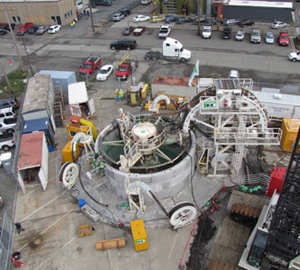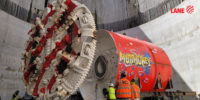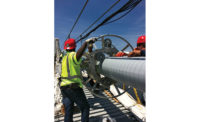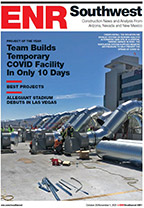
For the James W. Fowler Co. of Dallas, Ore., using a vertical shaft machine made by Germany’s Herrenknecht for a 145-ft-deep, 30-ft-dia launching portal as part of a $32-million sewer upgrade project in Seattle—the first time the technology has been used in the U.S.—was a matter of necessity.
Michael McMillan, Fowler project manager, says his firm started discussions with Herrenknecht—a company with whom Fowler already had a relationship—after King County delayed the award of the contract to Fowler by a year and six months. As a result, Fowler lost its slurry-wall subcontractor because that company couldn’t hold on to its original price. Forced to hold its bid price to retain the contract, Fowler started talking to the German firm. "We talked about the VSM [vertical shaft machine], and they showed us a presentation," he says. "It seemed like a quick way of getting a caisson [constructed], and we were able to stay within the contract budget."
Essentially a micro-tunneling machine, the one-meter-tall, 1.4-in.-thick VSM shaft segment works in a flooded shaft, digging out water and soil as it churns and allowing the operator to add sections of caisson as the machine advances. Strand jacks control the descent, and crews can get under the VSM shaft if they need to remove a bolt or lodged rock—something a crane doesn’t allow in traditional shaft construction, Noble says.
Marty Noble, King County project manager, says crews are just now prepping the machine that will give Fowler a deeper caisson shaft than could otherwise be accomplished with traditional caisson methods, which typically max out at around 80 ft. Drilling should start some time in late April or early May.
Along with the added ability to dig deeper and with increased accuracy, the VSM will do so more quietly and cleanly. The VSM runs on city power, not a diesel generator. “These things are increasingly put in urban environments where you keep as quiet as you can or spend hundreds of thousands of dollars on a sound wall,” Noble says. “It is a big advantage.”
Located in the Seattle residential neighborhood of Ballard, the VSM works well in the tightly confined urban spaces and is able to deal easily with the variety of thick seams of clay that crews will encounter.
Capable of excavating and lining—the design calls for 180 total precast-concrete segment liners throughout the project—three to 15 feet each day, the shaft should be completed in June. From there, crews will launch a tunnel-boring machine in September to build a 10-ft-dia, 2,000-ft-long tunnel under the Lake Washington Ship Canal.
In need of being replaced, the 77-year-old wooden sewer pipe carries 60 million gallons of wastewater each day. The tunnel will match up with a 90-ft-deep shaft that was created using a secant pile, a project that maxed out the depth for that type of shaft, on the other side of the canal.





Post a comment to this article
Report Abusive Comment